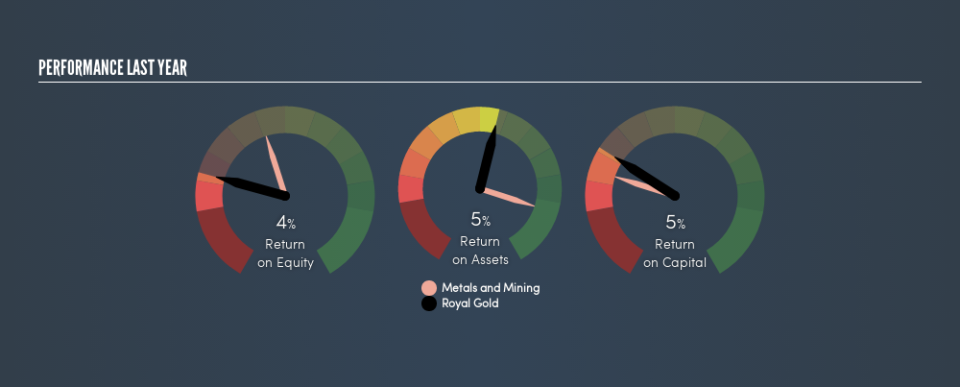Is Royal Gold, Inc. (NASDAQ:RGLD) Struggling With Its 5.1% Return On Capital Employed?

Want to participate in a short research study? Help shape the future of investing tools and you could win a $250 gift card!
Today we are going to look at Royal Gold, Inc. (NASDAQ:RGLD) to see whether it might be an attractive investment prospect. In particular, we'll consider its Return On Capital Employed (ROCE), as that can give us insight into how profitably the company is able to employ capital in its business.
First up, we'll look at what ROCE is and how we calculate it. Second, we'll look at its ROCE compared to similar companies. And finally, we'll look at how its current liabilities are impacting its ROCE.
Understanding Return On Capital Employed (ROCE)
ROCE is a metric for evaluating how much pre-tax income (in percentage terms) a company earns on the capital invested in its business. In general, businesses with a higher ROCE are usually better quality. In brief, it is a useful tool, but it is not without drawbacks. Author Edwin Whiting says to be careful when comparing the ROCE of different businesses, since 'No two businesses are exactly alike.'
How Do You Calculate Return On Capital Employed?
The formula for calculating the return on capital employed is:
Return on Capital Employed = Earnings Before Interest and Tax (EBIT) ÷ (Total Assets - Current Liabilities)
Or for Royal Gold:
0.051 = US$136m ÷ (US$2.7b - US$49m) (Based on the trailing twelve months to March 2019.)
Therefore, Royal Gold has an ROCE of 5.1%.
View our latest analysis for Royal Gold
Does Royal Gold Have A Good ROCE?
When making comparisons between similar businesses, investors may find ROCE useful. We can see Royal Gold's ROCE is meaningfully below the Metals and Mining industry average of 9.1%. This performance is not ideal, as it suggests the company may not be deploying its capital as effectively as some competitors. Regardless of how Royal Gold stacks up against its industry, its ROCE in absolute terms is quite low (especially compared to a bank account). There are potentially more appealing investments elsewhere.
As we can see, Royal Gold currently has an ROCE of 5.1% compared to its ROCE 3 years ago, which was 3.3%. This makes us wonder if the company is improving.
When considering ROCE, bear in mind that it reflects the past and does not necessarily predict the future. ROCE can be misleading for companies in cyclical industries, with returns looking impressive during the boom times, but very weak during the busts. ROCE is only a point-in-time measure. Given the industry it operates in, Royal Gold could be considered cyclical. Future performance is what matters, and you can see analyst predictions in our free report on analyst forecasts for the company.
How Royal Gold's Current Liabilities Impact Its ROCE
Current liabilities are short term bills and invoices that need to be paid in 12 months or less. Due to the way ROCE is calculated, a high level of current liabilities makes a company look as though it has less capital employed, and thus can (sometimes unfairly) boost the ROCE. To counter this, investors can check if a company has high current liabilities relative to total assets.
Royal Gold has total liabilities of US$49m and total assets of US$2.7b. Therefore its current liabilities are equivalent to approximately 1.8% of its total assets. With barely any current liabilities, there is minimal impact on Royal Gold's admittedly low ROCE.
What We Can Learn From Royal Gold's ROCE
Still, investors could probably find more attractive prospects with better performance out there. Of course, you might find a fantastic investment by looking at a few good candidates. So take a peek at this free list of companies with modest (or no) debt, trading on a P/E below 20.
For those who like to find winning investments this free list of growing companies with recent insider purchasing, could be just the ticket.
We aim to bring you long-term focused research analysis driven by fundamental data. Note that our analysis may not factor in the latest price-sensitive company announcements or qualitative material.
If you spot an error that warrants correction, please contact the editor at editorial-team@simplywallst.com. This article by Simply Wall St is general in nature. It does not constitute a recommendation to buy or sell any stock, and does not take account of your objectives, or your financial situation. Simply Wall St has no position in the stocks mentioned. Thank you for reading.

 Yahoo Finance
Yahoo Finance 
